Junior Nature Trail

This trail was developed for kids in memory of Mary Shannon. Mary was a volunteer here at Eaton Canyon for many years and was president of the Nature Center Associates. This trail was most recently refurbished with new metal trail name plates & freshly painted posts in 2023 by volunteers and staff. As you walk along the trail, take time to stop, look, and listen for the birds and other wildlife all around you!
LET'S BEGIN...
Head away from the nature center building through the small staff parking lot on the north side to Stop #1.

Western Sycamore
Tree and Pond
Stop 1: Sycamore Tree and Pond
On your right is a Western Sycamore tree, the one with the light-colored bark. In spring the growing green leaves are covered in fuzz. Hummingbirds like to use this fuzz to line their nests! In summer the leaves are large, green, and look a bit like a hand with fingers. In fall the leaves turn a golden yellow, then dry and brown, and then fall to the ground. In winter the sycamore’s branches are almost bare.
Although this pond is manmade, it shows how important ponds are to the ecosystem. Look for insects that live around the pond. Some of them can stand on water! Do you see any fish? These small fish are called Mosquito Fish. What do you think they eat? Do you see any other pond wildlife or algae (green growth on rocks or in water without leaves)? You might be able to find frogs. They eat the insects around the pond. Do you see or hear any birds? Can you mimic any of the birds’ calls?
Keep traveling on this path, with the pond on your left and the picnic benches on your right, looking to the right for Stop #2.
Stop 2: Matilija Poppy and Flat-topped Buckwheat
On your left is Flat-topped Buckwheat, just about a small child’s height. In summer the flowers look like tiny pink and white bouquets, and sometimes turn snowy white. Bees love to visit these flowers. These plants don’t need a lot of water, which helps them survive here, where there isn’t usually much rain. In fall the flowers turn a rusty brown. The fruits produce many seeds. Birds eat them during the day, and mice eat them at night.
The other bush here is VERY tall! It is called Matilija Poppy and has big white and yellow flowers that bloom in the late spring. Before the flowers bloom you can see a green bud the size of a large cherry. Look carefully and you might even find one with a piece of the white flower petal just poking out. Be careful though, the stems are prickly! Try smelling the flower: does it have a smell? The common name for this flower is “fried egg flower.” Can you see why? The Matilija Poppy has one of the largest flowers of all native California plants.
Do you see any bees on the flowers of either of the plants? Which plant’s leaves are bigger, or are they the same size? Are the leaves of both the same shade of green?
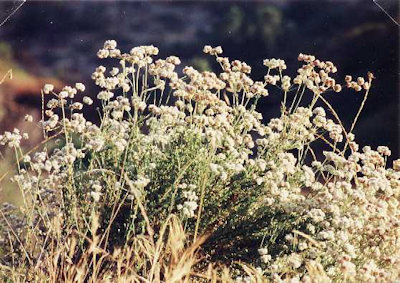
Flat-topped Buckwheat

Matilija Poppy
Continue straight ahead for just a few steps to see on the left, Stop #3.

Coast Live Oak
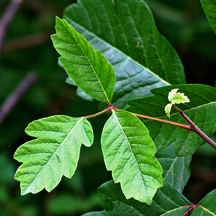
Poison Oak
Stop 3: Oak Tree
Look at the big oak tree. It is a Coast Live Oak. It is called “live” because it has leaves even in winter, when other types of oak may have lost their leaves and only have bare branches, looking dead. If you touch the bark you will find it rough and thick. It helped this tree survive a huge fire in 1993! This big oak tree grew from a tiny acorn. Now, in the fall, it has acorns of its own! Not all of its acorns will grow into oak trees though. Most will be eaten by animals such as mule deer, ground squirrels, acorn woodpeckers, scrub jays, and many insects.
Another plant that often grows around oak trees is the bush, Poison Oak. It has 3 leaflets on every stem. If you see it around the canyon, don’t touch it! It will make you itch, itch, itch!
The distance around a Coast Live Oak trunk can get to over 10 feet! Can your arms go all the way around this tree, or would it take more kids to completely encircle it in their arms?
Turn to your left on the new trail to get to (on left) Stop #4.
Stop 4: Sugar Bush
Sugar Bush has shiny, thick, bright green leaves that fold in the middle. Most of the year it has clusters of pink buds. They open into white flowers in spring that then turn into red berries with sticky hairs. The plant has a sticky, gooey substance on it that attracts bees, butterflies, and birds.
Native Americans used the fruit to sweeten their drinks (see where the name comes from?) Are the stems green, brown, or some other color?

Sugar Bush
Go straight down the trail to (on right) Stop #5.

Mugwort

Branching Phacaelia
Stop 5: Mugwort and Phacaelia
Mugwort is a funny name. Try saying it different ways. It particularly sounds strange if you use a low voice. The way this plant survives here, where there isn’t usually much rain, is to turn some leaves over when it is very hot. This lets them show their white undersides instead of their green tops. The light color will reflect sunlight and keep them cooler, so they don’t lose as much water. Do these leaves really have white undersides? Lift one to see.
In front of the Mugwort is a Phacaelia. This plant may only be green with blue-purple flowers in the spring. To some, the way the flowers open resembles a caterpillar. Do you think so? They are a beautiful blue-purple and attract our local native bees. Did you know we have native bees? Many of them are much smaller than the bees you usually see which are the European honey bee. Our native bees mostly live in the ground, on their own, and not in colonies like regularbees. They normally won’t sting you but don’t grab one with your hand because the female native bee will sting you.
Continue along the trail to (on right) Stop #6.
Stop 6: Black Sage
Right near the sign is Black Sage. Its leaves aren’t actually black, but are much darker than the very light grey-green leaves of White Sage, which also grows in the park. Black Sage’s dark green leaves are wrinkled. Pale blue flowers bloom in circles along the tall stems in spring and early summer. Bees love the flowers of Black Sage and help to spread its pollen.
Sages are in the Mint family. Many plants in this family have a distinctive smell. To best test for smell, gently rub a leaf with your fingers, then smell your fingers.

Black Sage
Follow the new trail to the left to get to (on left) Stop #7.

Laurel Sumac
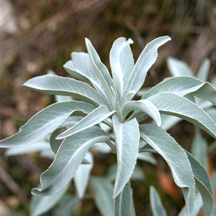
White Sage
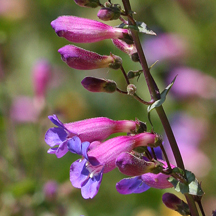
Showy-penstemon
Stop 7: Laurel Sumac and White Sage
Behind you is Laurel Sumac, perhaps the most common big bush in the Natural Area, often over 8 feet tall. You can see that the stems are reddish purple near the ends. If you had to compare the leaves to either a tugboat or a canoe, which would you say they’re closer to? The flowers of Laurel Sumac are tiny white 5-pointed stars on a Christmas tree-shaped support. If there aren’t any flowers right now, do you see any of the supports from last year’s flowers? Are all of these the same color, or are some maybe faded to grey and more worn-looking? You can often see 2 years’ worth of these flower supports.
Just left of this Laurel Sumac is White Sage (remember, the leaves are not actually white, but a light grey-green). Whereas I, who wrote these words, like the smell of Black Sage, I am not crazy about the smell of White Sage. Gently rub a leaf. What do you think?
This is a place where people might see California Ground Squirrels or Audubon’s cottontail rabbits. The very best time to see animals when you visit, though, is very early in the morning, just as it is getting light, or just as it is getting dark. The best thing you can do to make it more likely that you will see an animal is to be completely quiet and still for at least 5 minutes. This is still not a guarantee.
You may also see Penstemon here. It has stiff leaves with prickles along
the edges, and doesn’t get as tall as a grownup. The leaves are opposite. This
means that wherever you see a leaf come out on one side of the stem, there
will be another one even with it on the other side. Now look above or below these leaves. Do you see how these leaves are not directly above or below the others, but moved halfway in between? This continues all up and down the stem. If there are flowers you are in luck – they are an amazing blue-purple.
Continue on this path to (on right) Stop #8.
Stop 8: Scale Broom
The scruffy-looking plant behind the sign is called Scale Broom. Can you guess where the name came from? Look at the stems. They are covered in scales, which are actually the leaves! In the fall, yellow flowers dot this plant. Tiny “parachutes” carry seeds away in the breeze to make new plants. They go farther when it is windy.
Have you seen any other plants that have such tiny leaves? Do the leaves look similar to those of the Flat-topped Buckwheat? One of those is growing behind you on the other side of the trail.

Scale Broom
A few steps further (on right) to Step #9.

Coast Live Oak

Western Sycamore
Stop 9: Mountains and Trees
Look up at the mountains. Our San Gabriel Mountains are special because they belong to one of only two mountain ranges in the entire Unites States that run more east-west than north-south! This is called a “transverse” mountain range. Because Eaton Canyon Natural Area is right next to the huge National Forest of the San Gabriel Mountains we can get big creatures like mountain lions, black bears, and deer in our park.
Unlike many parks, our Natural Area mainly has just two kinds of trees – you saw them at stops #1 and #3. Here you can practice telling them apart. The Coast Live Oak has smaller, darker green leaves that will be on the tree all year, a darker trunk, and a round shape. The Western Sycamore’s leaves are larger, a paler green, and won’t be on the tree at all in winter. Its trunk is light colored and its overall shape more slender than the oak. As you walk on, try to identify whether the trees you pass are sycamore or oak, as nearly all will be one or the other.
Continue on this trail to (on right) Step #10.
Stop 10: Rocks
Look at the rocks in front of you. Do you see one with black spots like a Dalmatian dog? Geologists call it Lowe granodiorite. How about a white rock with small black speckles? Wilson quartz diorite, ‘salt and pepper rock’ as a nickname. An orangish-pink rock? Granite pegmatite, or ‘pink Peggy.’ Perhaps a black rock that sparkles in the sunlight? Biotite mica schist (The sparkly part is the mica). Just like the oak and sycamore trees, you can look for these rocks throughout our Natural Area.
In the summer lizards like to come out and sunbathe on the warm rocks. Snakes, bugs, and other animals sometimes like to sneak under rocks for shelter.

Lowe granodiorite
Just turn around for Stop #11.
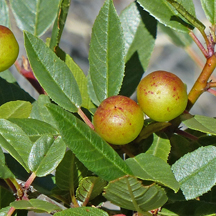
Coffeeberry

Showy-penstemon
Stop 11: Coffeeberry
The big, tall bush is called Coffeeberry. Inside its berries are shiny black seeds that look like coffee beans. But this plant isn’t in the same family as the actual coffee bush. Deer and coyotes love to eat the berries, which turn from green to red, and then to black or deep purple when ripe. The shiny green leaves are beautiful all year long. Band-tailed Pigeons fly all the way from the mountains to the foothills just to feed on the berries. Can you see any fruits now? Are they all the same color? Does the plant smell like coffee?
In the spring you may see beautiful purple Penstemon here. Notice the Black Sage you met in Stop #6 is here too. All of the flowers on this Nature Trail are natives. No one planted them or watered them. They grew from seeds that came from plants living here, and used only the water from rain.
End of Trail… Turn left at 1st trail, right at next, to go back to the Nature Center!

Trail Guide Revised in 2024 by:
Laura Nicholson (Docent-Naturalist & NCA President)
and
Brenda Hurst (Docent-Naturalist & ECNCA President).
